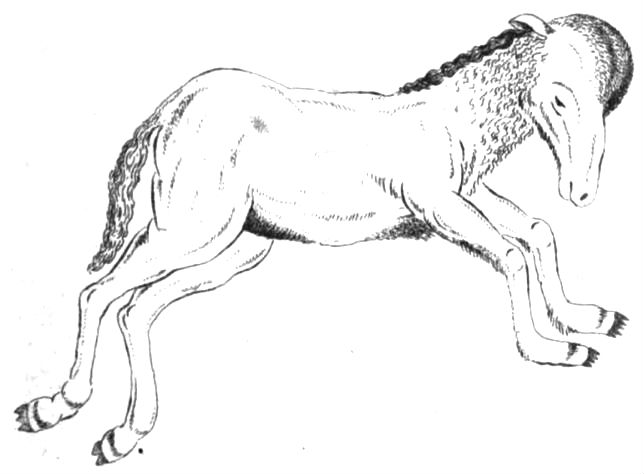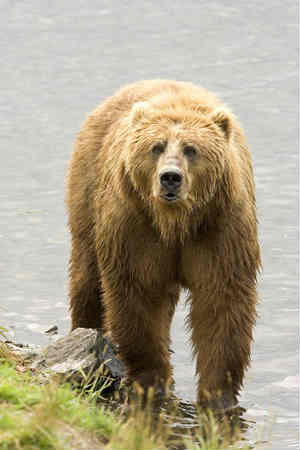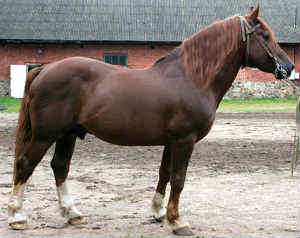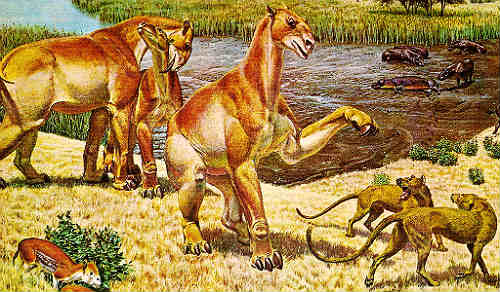A Bear-horse Hybrid?
Mammalian Hybrids
EUGENE M. MCCARTHY, PHD GENETICS, ΦΒΚ
|
A diligent scholar is like a bee who takes honey from many different flowers and stores it in his hive.
—John Amos Comenius
|
In the German language journal Der Schweizerische Beobachter (1807, pp. 48-52), a description is given of an ostensible bear-horse hybrid born alive in 1805 at a dairy near the Swiss city of Le Locle. Though this animal was the offspring of a mare, its head was supposedly in part like a bear’s, its coat over its entire body was shaggily ursine, and its feet bore claw-like appendages instead of hoofs.
The owner of the mare birthing this weird creature was a dairyman by the name of Alexis Simonin. Simonin made regular milk deliveries with the mare to Le Locle, and in the article, the strange birth was attributed to the mare having been frightened by a pair of dancing bears who had been brought to entertain guests at a local inn. In the early nineteenth century, the proposal of such an explanation for the birth of a foal with bearlike features would have been readily embraced. Up until the early twentieth century, physicians had believed for centuries that such maternal frights could stamp the traces of animals on the unborn. So the article, entitled An Account and Description of a Remarkable Monstrosity (Geschichte und Beschreibung einer seltsamen Misgeburt ), begins with an explanation of the strange birth’s origins in terms of the events in Le Locle, which is omitted here, and it then turns to the following account (translated from the original German by E.M. McCarthy):
It was on May 16th, 1805 that this mare produced an unnatural and shockingly misshapen foal that indeed had the true voice of a bear. It was a male. The mother, far from caring for it in the same way she had watched over all her previous foals, sought to keep this one at a distance with kicks.
The dairyman [i.e., Simonin] was away and his workers imagined, from prejudice or superstition, that such a monster would bring a curse upon the livestock, and they decided, especially given that they could not imagine how this monster could ever be of any use, to kill it. And so, after a few hours that is what they did, albeit with a great deal of trouble, as the beast turned out to be surprisingly strong. They then buried it right away.
When all this became known in Le Locle two days later, residents came to investigate the story on the spot and had the beast dug up and taken back to town. There, for two days, it lay in a barn where everyone hurried to see it, and everyone avowed that Simonin’s workers had exterminated a work of nature that should have been kept alive by any means possible. Its course of development would have been a matter of fascination for naturalists and might have cast light on the broader workings of nature herself, which are as yet shadowy and little known and over which the opinions of naturalists are sharply divided.
One would have liked to have this monstrosity stuffed, but since that could not be accomplished, one must settle for the illustration accompanying this article [shown below], which accurately shows the nature of this animal, and the following description of the same:
 Drawing of an ostensible bear-horse hybrid born near Le Locle, Switzerland in 1805 (source).
Drawing of an ostensible bear-horse hybrid born near Le Locle, Switzerland in 1805 (source).
The head: The upper half fully resembled that of a bear, not only in its form, but also with respect to the eyes, ears and hair. The lower half was as in a horse.
The neck was round and much shorter than in an ordinary foal. The hair, with the exception of the mane, lay in the opposite direction from that of the rest of the body, being turned toward the head.
The forelegs were natural as far down as the hoofs, which were bent forward like bearpaws making nearly a right angle with the rest of the leg. These feet ended in very hard, sinewy appendages, of which there were five on one foot and four on the other.
The body and hind legs were like those of an ordinary foal, with the exception of the hair and of those sinewy appendages, which were also present on the hindfeet, although there were only two on one foot, and three on the other.
Over the whole body the coat was gray and shaggy like a bear’s.
The voice was, according to the eyewitness testimony of seven or eight people, a true bear growl and bore no similarity whatsoever to the whinny of a horse.
When the live animal stood on its feet, it had an odd posture, in that it was very low in front, but very high toward the rear. In general, it was of about the same size as an ordinary foal.
The great crowd of people who saw it will bear witness that all of its various deformities obviously connected it to a bear.
With the exception of, perhaps, a few unintentional omissions, this report is taken word for word from the French language original, which was attested by several eyewitnesses as fully accurate and authentic.
In a contemporary news report about the Le Locle birth, the following witnesses are specifically named:
- Alexis Simonin, the owner of the mare;
- Lt. Heugenin, in whose barn the creature was exhibited;
- F. Troz, the mayor of Le Locle;
-
A. Auriet, author of the article above.
Note: If the creature born at Le Locle was in fact a rare bear-horse hybrid, the bear parent in question would have to be Ursus arctos, the brown bear, the only naturally occurring bear in Europe.
By the same author: Handbook of Avian Hybrids of the World, Oxford University Press (2006).


